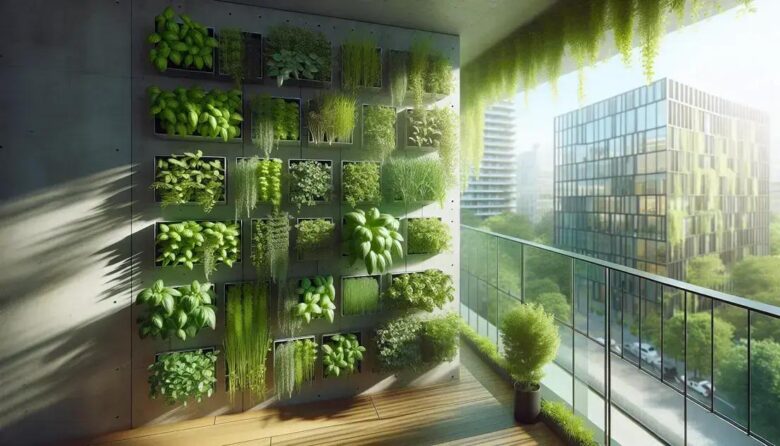Herb vertical gardens transform urban balconies into efficient green spaces by utilizing vertical growing structures, enhancing sustainability, and providing fresh herbs like basil and thyme while optimizing limited urban space.
Transforming urban balconies into lush, green spaces with herbal vertical gardens is not just trendy but a brilliant conservation move. Imagine having fresh herbs right at your fingertips, adding zest to your meals while also contributing to urban sustainability. Ready to dive into how you can create your very own herb oasis?
understanding herb vertical gardening
Vertical gardening is an innovative approach that maximizes limited space, making it ideal for urban environments. By growing herbs vertically, you can effectively use the wall or other vertical structures, bringing nature into compact spaces like balconies. This method not only saves space but also adds aesthetic value to your home. Vertical gardens can be created using shelves, hanging pots, or specially designed wall planters.
Choosing the Right Location
Your herb vertical garden needs a spot with adequate sunlight. Most herbs require at least 4-6 hours of sunlight daily. Consider the sun’s position relative to your balcony, and if necessary, think about installing adjustable fixtures to optimize sunlight catchment.
Basic Requirements
Ensure you have quality soil and proper drainage. Since vertical gardens rely on gravity, excess water should be able to drain freely to prevent root rot. Lightweight pots can help support the structure better. Regularly check and maintain moisture levels as vertical gardens may dry out faster.
benefits of growing herbs on balconies
Growing herbs on balconies offers a multitude of benefits for urban dwellers. One of the most significant advantages is having access to fresh and organic herbs year-round. This not only enhances cooking but also saves money you would otherwise spend at grocery stores. Fresh herbs are packed with flavor and nutrients, making your meals healthier and tastier.
Space Efficiency
Balconies are often underutilized spaces. By transforming them into herb gardens, you effectively use vertical and horizontal spaces. Herbs like basil, mint, and parsley thrive in pots, creating a green oasis in the middle of the city.
Environmental Impact
Herb gardening contributes positively to the environment. It bolsters urban biodiversity and can attract pollinators like bees and butterflies, promoting ecological balance. Furthermore, plants help reduce carbon dioxide levels and improve air quality.
Another benefit is stress reduction. Tending to plants has therapeutic effects, allowing you to unwind and enjoy nature right from your home. Herbal scents are also known to improve mood and mental clarity.
choosing the right herbs for your space
Selecting the right herbs for your space is crucial for a successful vertical garden. Start by considering the amount of sunlight your balcony receives. Many herbs, like rosemary and thyme, require plenty of sun, at least 6 hours a day. If your space is shaded, opt for mint or parsley, which thrive in lower light.
Herb Size and Growth Patterns
Consider the growth habits of each herb. Some, like basil, tend to grow bushy, while others like chives are more compact. Make sure to plant them where they have enough room to spread without crowding each other.
Climate and Care Needs
Your local climate also plays a role in herb selection. In cooler areas, hardier herbs like sage and oregano are better choices. Be mindful of watering needs; herbs like lavender require less water, making them suitable for drier climates or for gardeners who prefer low-maintenance plants.
Experiment with a mix of perennial and annual herbs to see what prospers best in your specific conditions, and don’t hesitate to try something new each season!
design ideas for vertical herb gardens
Designing a vertical herb garden allows you to get creative with your space. One popular method is using tiered shelves that can hold pots of various sizes. This setup utilizes both horizontal and vertical space, making it ideal for smaller balconies.
Wall-Mounted Planters
Consider installing wall-mounted planters which offer a sleek and modern aesthetic. These planters come in different materials such as metal or wood, and they can be arranged in patterns for visual interest.
Hanging Baskets
Hanging baskets are perfect for adding layers and depth to your garden. They work well for cascading herbs like oregano and thyme, allowing them to drape downwards attractively.
Using recycled materials can add a sustainable touch to your design. Old pallets, cans, or bottles can be repurposed into unique planters. Combining different design elements will not only make your garden functional but also a beautiful feature of your living space.
caring for your vertical herb garden
Proper care is essential to keep your vertical herb garden thriving. Regular watering is crucial, especially since vertical setups can dry out faster than traditional gardens. Ensure each pot has adequate drainage to prevent waterlogging, which can harm plant roots.
Soil and Fertilization
Choose a high-quality potting mix that retains moisture yet allows good drainage. Fertilize your herbs every few weeks with a balanced liquid fertilizer to encourage growth. Be cautious of over-fertilizing, as this can lead to lush foliage but less flavor in the herbs.
Pest Control
Pests like aphids or spider mites can be managed by regularly inspecting your plants and using natural solutions like neem oil if necessary. Encourage beneficial insects such as ladybugs to help control pest populations.
Pruning is also vital. Regularly trim herbs like basil and mint to prevent them from becoming leggy and to promote bushier growth. This not only enhances the garden’s appearance but also keeps your herbs productive and fragrant.
sustainable practices for urban gardening
Embracing sustainable practices in urban gardening helps reduce environmental impact while enhancing garden health. One effective method is using compost created from kitchen scraps to enrich your soil. This not only recycles waste but also provides plants with essential nutrients naturally.
Water Conservation
Water conservation is vital in sustainable gardening. Utilize rain barrels to collect rainwater for watering plants. Choosing drought-resistant herbs like lavender or rosemary can further reduce water use.
Organic Pest Control
Implementing organic pest control, such as companion planting, can reduce the need for chemical pesticides. For instance, planting basil near tomatoes can help deter pests naturally.
Maximize vertical space with recycled materials. Old ladders, pallets, or even bottles can be transformed into creative planters, reducing the need for new resources. By focusing on sustainability, you not only help the environment but also create a resilient and thriving urban garden.
Bringing Urban Balconies to Life with Herb Gardens
Creating a herb vertical garden on your balcony transforms your urban space into a refreshing green oasis. By choosing the right herbs and incorporating sustainable practices, you can enjoy fresh flavors year-round.
Designing an attractive and efficient setup not only saves space but also enhances the aesthetic appeal of your home. Tending to your garden with care ensures your herbs thrive, bringing both beauty and utility to your everyday life.
Remember, urban gardening is more than just growing plants; it’s about building a sustainable lifestyle that brings nature closer to your living space. Embrace the joy and benefits of a thriving herb garden right from your balcony.
FAQ – Common Questions About Herb Vertical Gardens on Urban Balconies
What are the best herbs to grow on a balcony?
Basil, mint, parsley, and thyme are great choices for balconies, thriving in pots with adequate sunlight and care.
How much sunlight do herbs need to thrive?
Most herbs require at least 4-6 hours of sunlight per day. Choose your herbs based on the light available on your balcony.
Can I use recycled materials for my herb garden?
Yes, using materials like old pallets and bottles can create sustainable planters while reducing waste.
How do I conserve water when watering my herbs?
Collect rainwater in barrels and use drought-resistant herbs like rosemary to minimize water usage.
What is companion planting and how does it help?
Companion planting involves growing herbs together that naturally deter pests, like basil with tomatoes, reducing the need for chemicals.
How often should I fertilize my herb garden?
Fertilize every few weeks with a balanced liquid fertilizer, but avoid over-fertilizing to maintain herb flavor.



